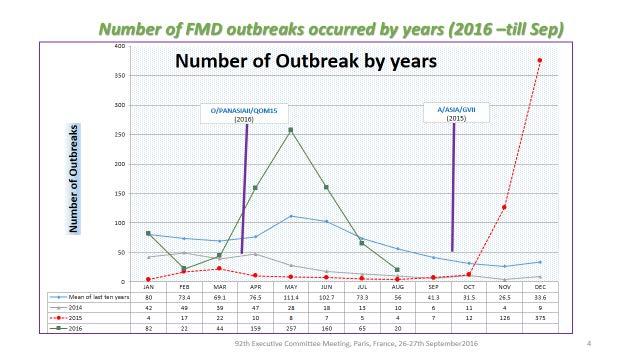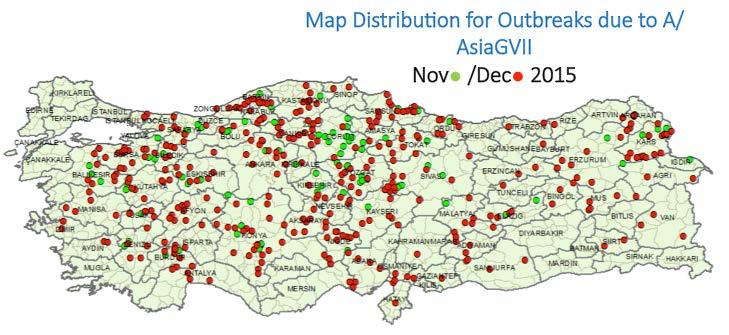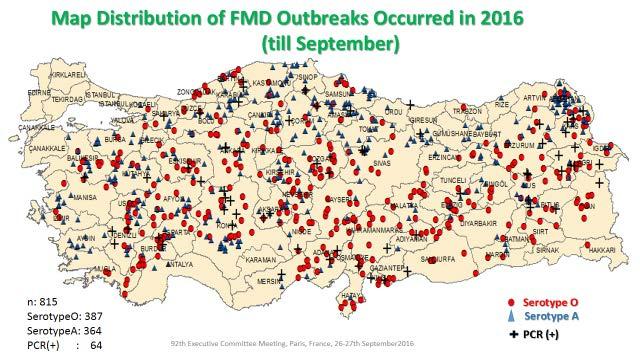
12 minute read
Item 5. Progress of Pillar II, Neighbourhood Activities
from 92nd Session of the Executive Committee of the European Commission for the Control of Foot-and-Mouth
by EuFMD
Executive for the work of Marius Masiulis, who had led the Contingency Planning work and supervised the Thrace and Balkans components for the past year. He considered that the emergency preparedness tools could be of wide use and he encouraged communication with the MS on these.
Dr Herzog also applauded the work with the Balkan countries and said the LSD situation had highlighted how essential it is to have both preparedness and rapid means to co-ordinate in a crisis. A regional plan is needed, not only for LSD but for FMD, rabies, and other issues. The EuFMD work had shown what can be done, but also its difficulties, and the need for local as well as international leadership. As the Tripartite meeting on THRACE could not be organised this year, the Executive Committee agreed that the upcoming meeting of the GF-TADs Standing Expert Group on LSD in Istanbul, 12th December, could be an opportunity to discuss the FMD prevention measures by the Tripartite, which could be as an extension of 1-2 hours to the GF-TADS meeting. Dr Doudounakis strongly supported this suggestion.
Advertisement
Conclusions 18. The impact calculator, the simulation exercise guidelines and the emergency preparedness selfassessment tools have the potential to assist the wider MS and following experience with their use in the Balkans, wider dissemination to the MS and training on their use should be considered. 19. The regional exercises in the Balkans have provided some positive indicators of what can be achieved at national and regional level. 20. Cases of PPR, SGP, but not currently LSD, are indicative of fresh incursions of animals or risk materials into Thrace region and surveillance for these is important part of the overall confidence in the biosecurity measures to prevent fresh introductions. 21. A regional plan to sustain improvement in preparedness could assist to safeguard and sustain efforts over the period 2017-2019. Such a plan could help clarify the EuFMD workplans for the same period. 22. EuFMD could assist in the development of such a regional plan, while recognising those countries concerned should fully support the goals to be achieved, and that OIE, EC, FAO and others are engaged in wider health initiatives in the Balkan region, and that there are likely to be in a range of health issues, not only FMD.
Item 5. Progress of Pillar II, Neighbourhood Activities
5.1 Report on the situation in Turkey
The report on the FMD situation in Turkey and neighbours was provided by Dr A. Naci Bulut, Şap Institute (Appendix 5), on behalf of Dr Nihat Pakdil, Deputy Secretary of Ministry, The Ministry of Food, Agriculture and Livestock, Turkey. Dr Bulut’s presentation was discussed by the Executive, since he was not able to join by a reliable connection. He reported that in the period 1st January to 31st August, 2016 a total of 802 outbreaks (O, A) had been reported in Turkey. The Asia 1 serotype had not been observed since July 2015. In the year since 1st September 2015, over 1300 outbreaks had occurred, whereas only 105 had occurred in the 12 months to 31st August 2015. The dramatic change related to two new incursions, of the serotype A -Asia (GVII) and a new variant of O PanAsia II (Qom15). The response to the first has been previously described, of development of a homologous vaccine and re-vaccination of the national cattle herd. The second epidemic took off in March to May but has declined since. Neither epidemic has finished, as cases continue. No outbreaks were detected in Turkish Thrace.
Figure 1: FMD outbreak data from Turkey, indicating outbreaks due to Serotype A (red dashed line). Reproduced with permission from presentation given by Dr A Bulut to the Executive Committee
The control measures in 2016, as indicated in this presentation were:
• An earlier than normal spring 2016 vaccination campaign (cattle) (December 2015-15th March 2016), with
SR included in some area in which it has been identified high risk. 17.5 million doses of tetra-valence vaccine (13.5 campaign + Emergency + SR) has been used for campaign vaccination and achieved >93% coverage. • In summer, May-August, second vaccination campaign was implemented, 18.5 million doses vaccine were used with 94% coverage. • Between September-November, an additional vaccination campaign in Marmara and Aegean regions
will be given.
• Booster vaccination has been also implemented for primo-vaccinated cattle in Marmara, Thrace and
Aegean regions. • To reduce risk from East, booster vaccination has been planned in provinces which have been identified as high risk in North East Anatolia, and emergency vaccination in response to outbreaks including in SR. In parallel, Clinical surveillance and outbreak case studies have been continued. Movement and animal market control measures has been strictly monitored. Markets and movements have been banned in the area in which it was identified high risk. In terms of policy development, a specific control policy has been developed for Marmara & Aegean regions but not yet initiated, as part of the plan to enter PCP stage3. A workshop is proposed on this to be organized by GDFC; EuFMD support for this, with technical expertise, is requested to come under the Component 2.1, support to PCP progress in Turkey.

Figure 2: Geographic distribution of outbreaks reported in Turkey due to Serotype A Gen VII FMD virus in November and December 2015, reproduced with permission from the presentation given by Dr A Bulut to the Executive Committee.

Discussion
Don King pointed out that Turkey had not been affected by the O India 2001 epidemic, but had by the A /Asia/GVII epidemic. The reasons for this are not clear, but it appears the type A may have been an extension from the south (Iraq/Saudi Arabia) where the epidemic of this strain was occurring in mid-2015, whereas the A Iran 05 lineages continue to circulate in West Eurasian countries including Turkey.
The situation was of concern to many members. How was it possible to have so many outbreaks, despite using tetravalent vaccine at a high coverage? The data provided did not provide an explanation for this. More detailed analysis is needed to understand if the width of distribution is mirrored in the incidence in affected herds, or
whether the width merely indicates entry of infection but few cases per infected village were found. In other words, the serological monitoring is also important since it provides evidence of whether circulation has reduced (in some or many vaccinated areas) even if the headline number of outbreaks remains high. The relatively short duration of the peaks may give an indication of the underlying transmission. Short, intense epidemics affecting wide areas suggests that spread is relatively unlimited, and post-recovery immunity (perhaps with vaccination) rapidly controls the epidemic – until it becomes persistent and circulates at low incidence. The evidence that vaccination is bringing epidemics under control remains scarce. Veterinary services like to claim their measures controlled outbreaks but most observe similar epidemic trends to that seen here in Turkey.
Conclusions
1. The situation remains of grave concern with two major epidemics in the past 12 months. Although these may be expected normally to be followed by a period of relative calm, the continued circulation of A /Asia/GVII as an exotic virus to the European region is of much concern. Regular, monthly reporting on the circulation of FMDV strains in Turkey would assist risk assessment. 2. The Executive welcomes the establishment in GDPC of the epidemiology and monitoring unit and urges that this becomes fully functional and able to provide the level of monitoring information that will bring confidence the control programmes are having their expected impact. This is also an expected requirement of PCP Stage 2, and after entry into Stage 3, greater evidence will be required of impact on circulation. 3. The indications in the report were welcomed that plans were being made for intensification of control measures for Marmara and Aegean regions to limit virus circulation, enabling these regions to be proposed as PCP Stage3, in 2017. The Executive supported the request in the report for technical guidance on this from EuFMD, as part of the Component 2.1 workplan.
5.2 Co-operation in the Caucasus Region
This was provided by Gunel Ismayilova (EuFMD, Component Manager 2.1) and Mark Hovari (EuFMD). Of most significance is that the Risk-Based Strategic Plans (RBSP) of Armenia and Azerbaijan have been accepted into Stage 2, during the 7th Regional FMD West Eurasia Roadmap meeting in Bishkek, 6-8 of April 2016. Further assistance in the plan includes the design of the 2016 national sero-surveys of Georgia, Azerbaijan and Armenia. For Turkey, implementation of monitoring of RBSP and technical support for national epi-network in Turkey has supported mainly been through training, with the final week of the four- week Practical Epidemiology Training course completed on 23rd of September 2016. Following the last Executive, and in line with Activity 2.1.2.1 (Support better information exchange between risk managers in the West Eurasia Roadmap countries), a meeting was organized at the side of the 84th General Session of the OIE (25th May 2016) -on “Regional cooperation between Transcaucasia and neighbouring countries in the prevention and control of FMD and other major epizootic transboundary diseases”. Invitations to this were sent by the EuFMD, and agreement from FAO and OIE received to organize the meeting. CVOs of the six countries most directly concerned were present and full support was given to the initiative, in the form of unanimous agreement on each of the points of the “Statement of Intentions”, after an initial review and sharing of views. The high level FAO, OIE and EC representation was a great assistance and it is clear that this initiative must be seen as coming under GF-TADS. Following the meeting in Paris, and with the open invitation there from the CVO Georgia, a Regional Foot-and Mouth Disease (FMD) Simulation Exercise was held in Georgia on 12-15th of July 2016, with three countries
directly participating and two countries (Russian Federation, Turkey) being fully involved as active observers in the inject driven desktop and field exercise. The exercise was a great success, a first for those participating.
Significant plans include • The RBSP Development workshop in Bishkek, on the request of FAO and OIE. • Organisation of FEPC (FMD Emergency Preparedness Course) in Turkish language. • Follow-up of the "Statement of Intentions", including further work on improvement of regional cooperation in the prevention and control of FMD between Transcaucasia and neighbouring countries and information share, including monthly reporting by the countries. • Organisation of the workshop on clinical surveillance and control strategy for disease freedom in Marmara and Aegean regions
The Chairman reminded the Session of the valuable meeting held in Paris and the agreement reached there. The first steps had been well taken to follow-up with a simulation exercise that had also tested international communications of the neighbouring countries. The regular reporting by the countries on their disease situation in the border regions, or across the entire country, would be a big step forward, and as agreed in Paris, more discussions are needed on how this will be managed, between the countries and the OIE and FAO database systems.
5.3 REMESA
The President, Dr Jean-Luc Angot provided the report on this Component (Appendix 6), adding to the summary report provided with the documents. The REMESA work is broadly divided into support to develop risk based strategic plans (RBSP), in Libya and Mauritania; only the second can go ahead in country in current circumstances. As well as the support to FMD management in Tunisia, Morocco and Algeria, focussing on the issue of FMD circulation and the risks which must be addressed in vaccination and surveillance strategies. Finally, the team also support networking and capacity building, through a series of webinars provided in three languages, co-ordinated with REMESA support unit (OIE and FAO). The priorities for next six months are • Follow up on the targeted surveillance established in Morocco, Algeria and Tunisia; • Finalize the development of RBSP in Mauritania; • Support the development of the coordination framework - REMESA networks; • Maintain the collaboration and coordination with FAO and OIE in order to provide joint assistance and support; • Establishment of partnerships with training providers, located in the region (e.g. Universities). • Support the development of vaccination self-assessment tool, assist the design and implementation of field vaccine studies and promote risk based vaccination strategies
Discussion
The status of the regional vaccine bank was discussed. OIE indicated that the tender has not yet been published, as the funding had still to be consolidated. The EC also indicated they would financially support this. The Secretary indicated that at the meeting he attended in Tunis, organised by the OIE, the mechanisms by which the bank would operate were unclear. The countries could find that these are potentially counterproductive to good national planning, should the Bank appear as a mechanism to avoid investment in preventive vaccination. The operational details were all important and there was a need for this to be communicated. The OIE agreed to come back with more details.
Conclusion
23. The establishment of a vaccine bank for the REMESA countries is a welcome development. A report indicating the mechanisms and criteria for the access to the stocks contained in the Bank by countries in the region would be helpful for co-ordination in emergency situations and for contingency planning, and the OIE agreed to come back with more details on this at the next Executive.
5.4 Pillar II Training Programme –results of the needs assessment and proposed workplan
This was presented by Jenny Maud, EuFMD (Appendix 7). The component is new to the Phase IV programme, and has the aim of developing training courses of region –wide utility , which are able to be delivered in the three sub-regional actions, in appropriate languages and by EuFMD team or by training partners working under their supervision. A training needs assessment was carried out, managed by Gunel Ismayilova and Karima Ouali, across the 19 countries of the European neighbourhood.
Following this process, the team then assessed which would be the priorities for training, in relation to the likely degree of impact of change to achieve the agreed outcome of the Pillar II actions. Which training would most likely improve the national application of the PCP in ways that would reduce FMD RISK? Five priorities were identified:
Improved abilities to be achieved:
1. Farmer disease recognition, reporting, biosecurity, prevention
2. Regional/field veterinary services, biosecurity, disease sampling, reporting, investigation
3. Apply the Progressive Control Pathway and write a Risk Based Strategic Plan
4. Apply basic biostatistics and epidemiology to disease surveillance and control
5. Socio-economic analysis (impact and control measure decision making)
Risk analysis along the value chain
Vaccine tender specifications
Support to diagnostic testing at regional and central laboratories
Post vaccination monitoring
How it can be achieved:
Support to in-country training, job aids, cascade training
Endemic country oriented version of online FMD Emergency Preparation Course (FIT-C)
Introduction to the Progressive Control Pathway under final testing. Support to RBSP through PCP Practitioners’ Network. 4. Existing webinar series support.
Repurpose existing introductory e-learning as short open access modules to be used prior to workshops etc (translation)
Specific e-learning course to be developed
Specific e-learning course to be developed
Job aids or webinar
E-learning courses are to be developed under component 3.3 in partnership with the Pirbright Institute.
Training resources are to be developed under component 3.2.



